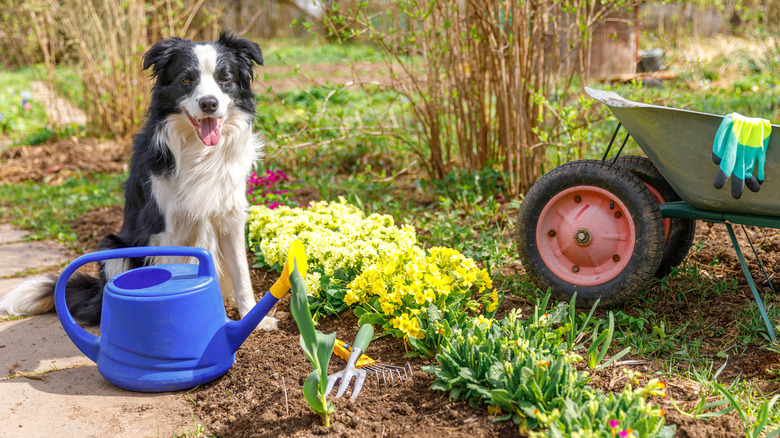Reconsider Using This Fly-Repellant Flower If You Have Pets
Looking for pet-friendly flowers you can grow to ward off insects? Plants in the mint or Mentha family, with their heavily scented leaves and blooms and quick growth, might be just the ticket. There's a particular outlier, though, that will have you second-guessing this sage (minty?) advice: pennyroyal. It's true that there's a lot of evidence to suggest pennyroyal can, indeed, keep away menacing insects. Research indicates that pennyroyal essential oil and extracts repel, for example, mosquitoes, beetles, flies, gnats, spider mites, and scale insects. And that's certainly attractive to those wanting to enjoy a buzz-free evening tipple on their open-air patio or balcony. However, the plant (and especially its extracts) contain toxic compounds that can cause, in the worst cases, liver failure when large doses are ingested by humans or pets prone to nibbling your backyard greenery, be it cats, dogs, horses, and even turtles!
Pennyroyal, or Mentha pulegium, is a member of the relatively large mint family. As such, it boasts a chewing gum-fresh smell, spreading root system (sometimes uncontrollably so), and puffy, purple, and intensely fragrant summer blooms. It has a lot of undeniably attractive properties, from the aforementioned heady scent to being an easy-grow, pollinator-attracting groundcover or lawn turf alternative. It boasts distinctive foliage, thrives in full sun to partial shade, and is deer- and rabbit-resistant. That's likely why it remains a popular cottage and container garden plant despite its downsides — especially the risk it poses to our fur-covered family members.
Why pennyroyal is a risk to your pets
We get it ... Keeping mosquitoes away from your home with an easy-to-grow herb sounds like a dream. And indeed, pennyroyal is a traditional folk remedy in native habitats in Europe, North Africa, and the Middle East; so much so that it's now endangered in the wild. However, pennyroyal contains a cytotoxin called pulegone that may cause liver and other organ injury or failure and even death if you eat (or drink) enough of it. Even rubbing it on your skin or that of your pets is a risk — it can cause contact dermatitis in those sensitive to irritants. Given that the issue is concentration, the leaves (fresh or dried) are probably safer than extracts for people and pets alike when used as an insect repellant. However, medical professionals advise against its unsupervised ingestion by humans and animals, and some experts say not to use pennyroyal essential oil at all for any purpose. Incidentally, pulegone is thought to make pennyroyal an effective insecticide.
American pennyroyal (Hedeoma pulegioides) is sometimes mistaken for its European counterpart. They're unrelated, but they look and smell similar. American pennyroyal also contains pulegone, making it toxic when eaten in large quantities. It's not a good swap for gardeners concerned about pet safety, despite being indigenous to the U.S. Another look-a-like native, Mountain pennyroyal (Monardella-odoratissima), could, on the other hand, work as a suitable and safe replacement — provided you're in USDA Hardiness Zones 3 to 8.
Can you grow pennyroyal in your backyard safely?
Not sure if the plant you have growing in the garden is pennyroyal? Examine the stamen of the flowers, which stick out past the petals in pennyroyal, or use one of the top plant-identifying apps to help you. If you're worried about pet harm, err on the side of caution and remove the plant. Depending on the size of a patch, you might have to hand-pull or mow over the plant for several years as the rhizomatic roots sprout new plants. If you still want to grow pennyroyal, first check its status in your state. The plant is listed as invasive in parts of California and Oregon due to its tendency to put roots down just about anywhere its stems fall.
The foliage and flowers are toxic to dogs and cats, so pennyroyal shouldn't be planted anywhere they could get a bite of it. Grow it in containers or hanging planters placed or hung up high in out-of-the-way spots where pets can't reach or never frequent. This will also help ensure the plant doesn't take over a garden bed or lawn or otherwise end up where you don't want it. When handling this plant, wear gloves, a long-sleeved top, and pants, and wash your hands before patting pets. The best option, however, if you want to plant mint family members in your garden, is to consider pet-safe varieties like wild mint, peppermint, spearmint, lavender mint, apple mint, and pineapple mint.


